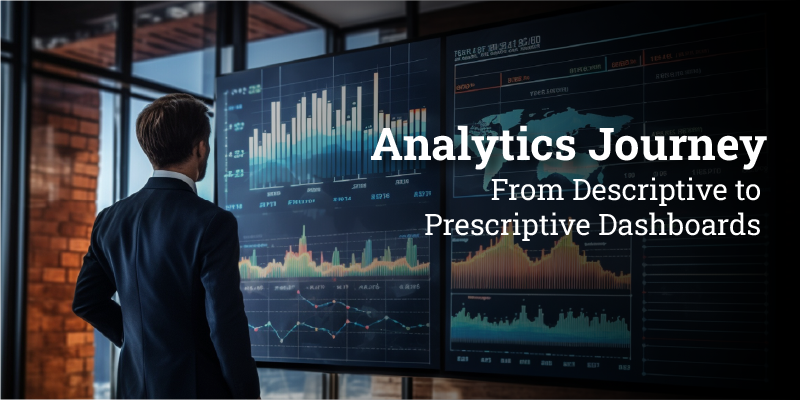Analytics Journey: From Descriptive to Prescriptive Dashboards

In the ever-evolving landscape of data analytics, the journey from descriptive to predictive to prescriptive dashboards represents a progressive deepening of insights and decision-making capabilities. Each type of dashboard serves a unique purpose, guiding organizations from understanding past performance to anticipating future trends and ultimately prescribing optimal actions to achieve desired outcomes. This journey not only transforms data into valuable insights but also drives meaningful improvements in Key Performance Indicators (KPIs).
Descriptive Dashboards: Understanding the Past
The journey begins with descriptive dashboards. These dashboards focus on summarizing historical data to provide a clear and concise view of what has happened. They are essential for monitoring KPIs, tracking performance metrics, and identifying trends over time. Descriptive dashboards answer questions like “What happened?” and “How did we perform?”
Key features of descriptive dashboards include:
- Data Visualization: Charts, graphs, and tables that represent historical data.
- Trend Analysis: Visualization of data trends to understand patterns.
- Performance Metrics: Monitoring of KPIs to evaluate performance.
For example, a sales dashboard might display monthly sales figures, revenue by region, and year-over-year growth. These insights help organizations understand past performance, identify areas of improvement, and make informed decisions based on historical data.
Predictive Dashboards: Anticipating the Future
As organizations mature in their analytics capabilities, they move towards predictive dashboards. These dashboards leverage advanced statistical techniques and machine learning algorithms to forecast future outcomes based on historical data. Predictive dashboards answer questions like “What is likely to happen?” and “What trends should we anticipate?”
Key features of predictive dashboards include:
- Forecasting: Predicting future trends based on historical data.
- Predictive Models: Using algorithms to identify patterns and make predictions.
- Scenario Analysis: Evaluating different scenarios to understand potential outcomes.
For instance, a predictive sales dashboard might forecast future sales based on historical trends, market conditions, and other relevant factors. By anticipating future performance, organizations can proactively address potential challenges, optimize resources, and capitalize on emerging opportunities as mentioned in this article.
Prescriptive Dashboards: Guiding Actions
The final stage in the analytics journey is the development of prescriptive dashboards. These dashboards go beyond predicting future outcomes by recommending specific actions to achieve desired results. Prescriptive dashboards answer questions like “What should we do?” and “How can we achieve our goals?”
Key features of prescriptive dashboards include:
- Optimization Algorithms: Recommending the best course of action based on data.
- Actionable Insights: Providing specific, data-driven recommendations.
- Decision Support: Assisting in strategic and operational decision-making.
A prescriptive sales dashboard, for example, might not only predict a decline in sales but also suggest targeted marketing campaigns, pricing adjustments, and inventory optimization strategies to mitigate the decline. By offering actionable insights, prescriptive dashboards empower organizations to make proactive, informed decisions that drive KPIs.
Moving the KPIs: The Ultimate Goal
The progression from descriptive to predictive to prescriptive dashboards is driven by the need to move KPIs and achieve strategic objectives. Descriptive dashboards lay the foundation by providing a clear understanding of past performance. Predictive dashboards build on this by offering foresight into future trends. Prescriptive dashboards complete the journey by recommending specific actions to influence outcomes.
This evolution in analytics capabilities enables organizations to:
- Improve Performance: By understanding and addressing past performance issues.
- Anticipate Challenges: By forecasting future trends and preparing accordingly.
- Optimize Actions: By implementing data-driven recommendations to achieve goals.
In conclusion, the analytics journey from descriptive to prescriptive dashboards transforms data from a retrospective tool into a proactive driver of business success. By leveraging the full spectrum of analytics capabilities, organizations can move their KPIs, achieve strategic objectives, and maintain a competitive edge in an increasingly data-driven world.
To learn more about building enterprise solutions with analytics and AI, check for our Masters and customised programs in Business Analytics.



